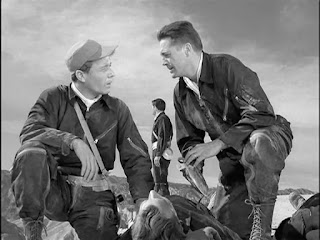Reno - 97 miles
Of course, Serling got unsolicited story ideas all the time.
He once described how he and his staff had gone through a stack of manuscripts where the majority were “hand-scrawled, laboriously written, therapeutic unholy grotesqueries from sick, troubled, deeply disturbed people.”
“Of the three remaining scripts,” he said, “all of clearly poetic, professional quality, none of them fitted the show."
But this time was different. Serling was so impressed with the proposal that he paid Champion $500 on the spot gave her on-screen credit for suggesting the story idea.
This would be the first and only time he’d do such a thing.
The result of this meeting was episode entitled “I Shot an Arrow into the Air,” which I recorded on Friday night.
And while I don’t think it’s a classic episode, it does present a strong story about how quickly people can resort to barbarism.
The story concerns three astronauts who are the only survivors when their rocket crash lands on a desert asteroid.
They have limited water, little supplies and no way of getting back to earth.
The episode was broadcast in 1960—nine years before the Apollo moon landing--and has been shown on TV innumerable times, but I’ll issue a spoiler alert at this juncture just in case you haven’t seen it.
'Make Tracks, Mr. Corey'
Champion’s story pitch to Serling came in the form of a simple question.
“What would happen if three guys landed on what they thought was an asteroid and it turned out to be outside of Las Vegas?" she asked.
What would happen? Well, a lot of bad stuff, actually.
One crew member, Corey, quickly gives into fear, arguing with his commander about giving an injured crew member because the poor guy is likely to die soon.
The episode was directed by Stuart Rosenberg, who would go on to direct many TV shows and such films as Cool Hand Luke, Brubaker and The Pope of Greenwich Village.
The program was shot in Death Valley National Monument, which is now a national park, particularly around Zabriskie Point, and Rosenberg does a great job of making the location look like a hostile alien planet.
Corey breaks down and finally resorts to murdering his fellow crewmembers before beginning a lone march through the burning desert.
When he finally comes to a ridge and looks down, he is horrified when he sees a highway, telephone lines and a sign reading “Reno-97 miles”, and realizes the astronauts never left the earth.
The episode has been criticized for its rather loose approach to science, with The Twilight Zone Companion complaining that “any astronaut who crash lands on a body within our solar system that has the same atmosphere and gravity of Earth and doesn’t immediately realize he is on Earth had better go back to astronaut school.”
Perhaps, but I’m more impressed with the quality of the filmmaking.
This is a science fiction story pretty much devoid of special effects, yet it is far more entertaining than a slew of CGI-bloated space operas.
Serling would later apply the theme of astronauts unknowingly returning to earth in his screenplay for Planet of the Apes.
Now that’s 500 bucks well spent.





Comments
"This is a science fiction story pretty much devoid of special effects, yet it is far more entertaining than a slew of CGI-bloated space operas."
Ain't that the truth! For as advanced as special effects have been developed over the years, to me, often times when I watch a movie that has a lot of CGI, I think it interferes with the movie because the movie becomes MORE about the CGI than the story. That's how I felt about the "Titanic" remake in 1997. Instead of feeling more real, that version of the "Titanic" felt more fake to me because it was CGI overload.
Have a great Monday, buddy!
P.S. LOVE your new blog template!
Oh, you are so right about CGI overpowering the story!
Sometimes I'll be watching one of these films and all I can think of some nerd in front of a computer creating all those bogus images.
Thanks for stopping by, buddy, and take care!
This is a really solid episode and that twist ending is a real shocker.
I think it works so well because we're not prepared for it. The only inkling we get is when a dying astronaut draws some lines in the sand.
We don't know what that means, though, until Corey comes over that ridge and looks down on the highway.
Not everything that happens in Vegas stays in Vegas.
Great stuff!
Hi, Dorothy!
I think this episode is worth looking up.
My issue with CGI is its overuse by some filmmakers.
Quentin Tarantino complained that directors were using CGI to shoot car chases--something that movie makers have been doing without special effects since the days of the Keystone Kops.
But CGI can also be a blessing to low budget filmmakers to create scenes or locations that were previously beyond their reach.
And I agree whole-heartedly that Welles made excellent use of light, shadow and angles.